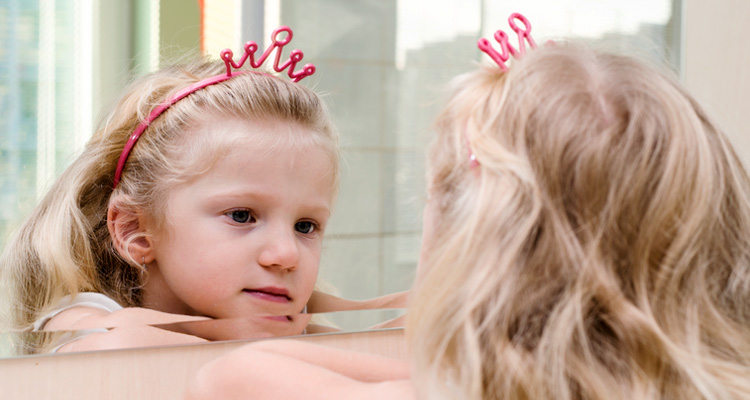A recently released study conducted by a Brigham Young University professor, Sarah M. Coyne, cited research supporting the harmful impacts of the Disney princess culture on preschool girls. There were two notable findings: the princess culture both perpetuates damaging gender-stereotypical behavior and worsens body-esteem over time.
The little girls exposed to significant interaction with Disney princesses engaged in more stereotypical female behavior such as playing with dolls and tea sets, as well as pretending to cook and clean. They avoided getting dirty or participating in risky behavior.
Claims in the study that girls experienced more negative self-esteem and body issues are thought to be based on their early exposure to the “thin ideal” presented by the Disney princesses.
This study suggests that exposure to these fairy-tale Disney princesses should be limited, and it is true that all things should be done in moderation. As a mother of a self-crowned princess, though, I would like to challenge the claims currently being circulated.
Stereotyped Behavior
While every child is unique in their interpretations and influences, what princesses are these girls watching to have these stereotyped behaviors manifested? I, along with my two daughters, see most Disney princesses from a completely different perspective.
Brave’s Princess Merida did not settle for the princes she was “supposed” to pick from to marry. Instead, she believed in herself and her skills and set out to prove as much to her parents and kingdom.
“Our fate lives within us. You only have to be brave enough to see it.” –Princess Merida
Aladdin’s Jasmine was another princess who did not accept her assumed fate of an arranged marriage nor was she satisfied with living a royal life. She sought more for herself.
“How dare you? All of you! Standing around deciding my future? I am not a prize to be won!” –Princess Jasmine
Princess Tiana, from Disney’s The Princess and the Frog, believed in her dreams, worked hard every day, and didn’t stop until she accomplished her goal, despite all the naysayers.
“The only way to get what you want in this world is through hard work.” –Princess Tiana
I could go on and on with a long list of inspirational princesses. Elsa, in Frozen, overcame and controlled a crippling “power,” finding love not in a prince but in her family. Mulan bravely fought in battle for China to save her sick father from having to fight. Belle (Beauty and the Beast) and Ariel (The Little Mermaid) were in constant pursuit of knowledge and education, and Cinderella overcame slave-like circumstances and abuse to create a better life for herself.
If these are all female gender-stereotypical behaviors, then I certainly do hope that my daughters will follow their lead and behave like these princesses.
Body Issues
When it comes to young and impressionable girls, it is certainly true you will find them wanting to “be just like” all kinds of different movie characters, music stars, or anyone they look up to. You will find them jumping on a chair rocking out with their spoon microphone or clomping around in your high heels and sparkly jewelry. Dress-up and imaginative play are absolutely necessary and healthy for development.
The issue comes when they start comparing themselves to others to the detriment of their self-esteem. Does the fault then lie on the role model, though? Should we guilt anyone who is more beautiful, more talented, or more successful than us because of our feelings of inferiority?
[Tweet “Harm is not in a girl thinking a princess is pretty—harm is in her thinking she herself is not.”]
It is not my job as a mother of two beautiful daughters to criticize anyone (including a princess) who is skinny, who has flawless skin or hair, who can sing better than my girls, who is more talented, etc. It is my job as their mother to raise my daughters to look in the mirror and see a beautiful young lady who was created perfectly without mistake and with a unique and special purpose in life.
If my little girl puts on a princess dress and all she can think about is how she is not the “thin ideal” that her favorite princess portrays, it is not Jasmine’s fault—it is mine for not having instilled in her the confidence to know that she is more beautiful than any princess I’ve ever seen.
As the opening of Beauty and the Beast states, “Beauty is found within.” Princess Belle loved the Beast, looking beyond his appearance into his heart; and in that same way, our little girls must be taught to do the same, for others and for themselves.
Obviously, no role model can be perfect (not even fairy-tale characters), so there are certainly flaws that can be found in the Disney princess culture. However, television or movie characters should not be a dominating influence in a child’s life. Allow your child’s imagination to soar as they pretend via these fairy tales to be royalty or super heroes or explorers, but ensure your influence as a parent supersedes any negative impressions.
So, the next time your little girl wants to play princesses, grab those plastic glass slippers, throw on some beads and enjoy a royal tea party. Remind her just how beautiful she is and how proud you are of her intelligence, bravery, strength, and kindness as a little princess!




































